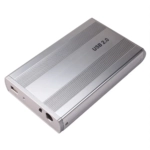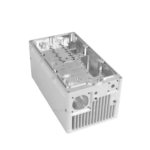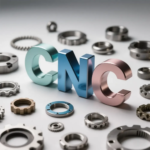Compared with the processing of cylindrical surfaces, the processing conditions of holes are much worse, and the processing of holes is more difficult than the processing of cylindrical surfaces. This is because:
1) The size of the tool used for hole processing is limited by the size of the hole to be processed, has poor rigidity, and is prone to bending deformation and vibration;
2) When using fixed-size tools to process holes, the hole processing size often directly depends on the corresponding tool size. Manufacturing error and tool wear will directly affect the hole machining accuracy;
3) When processing holes, the cutting area is inside the workpiece, the chip removal and heat dissipation conditions are poor, and the processing accuracy and surface quality are difficult to achieve. control.
1. Drilling and reaming
1. drilling
Drilling is the first step in machining holes in solid materials, and the hole diameter is generally less than 80mm. There are two ways of drilling: one is rotation of the drill bit; the other is the rotation of the part. The errors produced by the above two drilling methods are different. In the drill rotation drilling method, when the drill bit is deflected due to the asymmetry of the cutting edge and insufficient rigidity of the drill bit, the center line of the hole to be processed. will be deviated or it is not straight, but the diameter of the hole is basically unchanged; On the contrary, in the drilling method where the workpiece rotates, the deviation of the drill bit will cause the diameter of the hole to change, but the center line of the hole remains straight; .
Commonly used drilling tools include: twist drill, center drill, deep hole drill, etc. Among them, the most commonly used drill bit is the twist drill, and its diameter specifications are as shown in the picture.
Due to structural limitations, the bending and torsional rigidity of the drill bit is low. In addition, the centering performance is poor and the drilling accuracy is low, generally only reaching IT13~IT11. Surface roughness is also important, Ra is. generally 50.~12.5μm but the metal removal rate of drilling is large and the cutting efficiency is high. Drilling is mainly used to process holes with low quality requirements, such as bolt holes, threaded bottom holes, oil holes, etc. For holes with higher processing accuracy and surface quality requirements, they must be obtained by enlargement, reaming, drilling or grinding during further processing.
2. Expansion
Hole expansion involves using a reamer to further process a hole that has been drilled, cast or forged to expand the diameter of the hole and improve the processing quality of the hole. The hole expansion process can be used as a pre-treatment before completing the hole. hole, or as final machining of less demanding holes. A reamer drill bit is similar to a twist drill bit, but has more teeth and no beveled edge.
Compared with drilling, reaming has the following characteristics: (1) The reamer drill has a large number of teeth (3 to 8 teeth), good guidance and relatively stable cutting (2) The reamer drill does not have edge of chisel or cut; the conditions are good; (3) The machining allowance is small, the chip flute can be made shallower, the sprue can be made thicker, and the cutter body has better strength and rigidity. The hole expansion processing accuracy is generally IT11~IT10, and the surface roughness Ra is 12.5~6.3. Hole enlargement is often used to process holes with a smaller diameter than the image. When drilling a hole of a larger diameter (D ≥ 30 mm), a small drill bit (with a diameter of 0.5 to 0.7 times the diameter of the hole) is often used to pre-drill the hole, then a reamer of the corresponding size. is used to widen the hole. This can improve processing quality and production efficiency.
In addition to processing cylindrical holes, reaming can also use various special-shaped reaming drills (also called countersink drills) to process various countersunk seat holes and countersunk faces. The front end of the cutter is often equipped with a guide post guided by the hole being processed.
2. Ginger hole
Reaming is one of the hole finishing methods and is widely used in production. For smaller holes, reaming is a more economical and practical processing method than internal grinding and precision reaming.
1. Strawberry
Reamers are generally divided into two types: hand reamers and mechanical reamers. The handle of the hand reamer is a straight handle, the working part is long, and the guiding effect is good. The hand reamer has two structures: integral type and adjustable outer diameter type. Machine reamers have two structures: handle and sleeve. The reamer can not only process circular holes, but taper reamers can also be used to process taper holes.
2. Reaming process and its application
The bore allowance has a great influence on the quality of the bore. If the allowance is too large, the load on the reamer will be large, the cutting edge will dull quickly, it is difficult to obtain a smooth machined surface and dimensional tolerance. is not easy to guarantee if the tolerance is too small. If the knife marks left by the previous process cannot be removed, it will naturally not improve the quality of hole processing. Generally, the coarse bore tolerance is 0.35-0.15mm and the fine bore tolerance is 01.5-0.05mm.
In order to avoid the appearance of built-up edges, reaming is generally carried out at a lower cutting speed (v < 8 m/min when high speed steel reamers are used to process steel and cast iron). The value of the feed quantity is related to the diameter of the hole to be processed. The larger the hole diameter, the higher the feed quantity value. When processing steel and cast iron with a high-speed steel reamer, the feed quantity is high. is generally 0.3 to 1 mm/r.
Appropriate cutting fluid should be used for cooling, lubrication and cleaning when reaming to prevent the appearance of built-up edges and remove chips in a timely manner. Compared with grinding and reaming, reaming has high productivity and can easily ensure hole accuracy; However, reaming cannot correct the hole axis position error, and the hole position accuracy must be guaranteed by the previous process. Reaming is not suitable for processing stepped holes and blind holes.
The dimensional accuracy of the bore is generally IT9~IT7 level, and the surface roughness Ra is generally 3.2~0.8. For medium-sized holes and high-precision requirements (such as IT7 level precision holes), the drilling-expanding-reaming process is a typical processing solution commonly used in production.
3. Boring
Reaming is a processing method that uses a cutting tool to enlarge a prefabricated hole. Boring work can be done on a boring machine or lathe.
1. Reaming method
Boredom can be achieved in three different ways.
1) When the workpiece is rotating and the tool is feeding, most of the boring holes on a lathe belong to this boring method. The process characteristics are as follows: the hole axis after processing is consistent with the rotation axis of the workpiece, the roundness of the hole mainly depends on the rotation accuracy of the machine tool spindle and the error in axial geometric shape of the hole. depends mainly on the direction of feed of the tool relative to the axis of rotation of the accuracy of the position of the part. This drilling method is suitable for processing holes requiring coaxiality with the exterior surface.
2) The tool rotates and the workpiece moves forward. The boring machine spindle drives the boring tool to rotate, and the workbench drives the workpiece to move forward.
3) When the tool rotates and makes a feed motion, this reaming method is used to drill holes. The length of the boring bar overhang changes and the deformation of the boring bar also changes. The hole diameter is larger near the pin box and. away from the pin box. The diameter of the hole is small, forming a conical hole. In addition, as the length of the boring bar overhang increases, the bending deformation of the spindle due to its own weight also increases, and the axis of the processed hole will bend accordingly. This drilling method is only suitable for processing shorter holes.
2. Diamond drilling
Compared with ordinary boring, the characteristics of diamond boring are small amount of back cut, small amount of feed and high cutting speed. It can achieve high machining precision (IT7~IT6) and very smooth surface (Ra is 0.4~0.05). Diamond boring was initially processed with diamond boring tools, but is now commonly processed with carbide, CBN, and synthetic diamond tools. It is mainly used for processing non-ferrous metal parts and can also be used for processing cast iron parts and steel parts.
The commonly used cutting quantities for diamond reaming are: the back cutting quantity before reaming is 0.2-0.6mm, the final feed quantity is 0.1mm; the cutting speed when processing cast iron is 100-250 m; /min When processing steel, it is 150-300 m/min, and when processing non-ferrous metals, it is 300-2000 m/min.
In order to ensure that diamond boring can achieve high processing precision and surface quality, the machine tools (diamond boring machines) used must have high geometric accuracy and rigidity. Precision angular contact ball bearings or hydrostatic plain bearings are commonly used for machine tool spindle supports. , and high-speed rotating parts. It must be balanced precisely. In addition, the movement of the feeding mechanism must be very smooth to ensure that the workbench can perform smooth and low-speed feeding movement.
Diamond boring has good processing quality and high production efficiency. It is widely used in the final processing of precision holes in mass production, such as engine cylinder holes, piston pin holes, spindle holes on machine tool spindle boxes, etc. . However, it should be noted that when processing ferrous metal products with diamond boring, only carbide and CBN boring tools can be used, and diamond boring tools cannot be used, because the carbon atoms of diamond have a strong affinity with iron. elements in the group, the tool life is short.
3. Reaming tool
Boring tools can be divided into single-edged boring tools and double-edged boring tools.
4. Drilling process characteristics and scope of application
Compared with the drilling-expanding-reaming process, the hole diameter size is not limited by the tool size, and the reaming has strong error correction capabilities. The original hole axis deviation error can be corrected by multiple tool passes and the original hole axis deviation. The error can be corrected. Boring and positioning surfaces maintain high positioning accuracy.
Compared with the cylindrical bore of the lathe, due to the poor rigidity and large deformation of the tool holder system, poor heat dissipation and chip removal conditions, and the relatively large thermal deformation of the workpiece and tool, the processing quality and production efficiency of the bore are not as good. high like a cylindrical tower.
In summary, the above analysis shows that reaming has a wide processing range and can process holes of different sizes and different precision levels. For holes and hole systems with larger diameters and higher requirements for size and position accuracy, the bore is almost. the only method of treatment. The processing precision of the bore is IT9~IT7 level and the surface roughness Ra is. Boring can be performed on boring machines, lathes, milling machines and other machine tools. It has the advantage of flexibility and is widely used in production. In mass production, boring dies are often used to improve boring efficiency.
4. Sharpening holes
1. Sharpening principle and sharpening head
Honing is a method of finishing holes using a sharpening head with a grinding bar (whetstone). When lapping, the workpiece is fixed, and the lapping head is driven by the machine tool spindle to rotate and perform reciprocating linear motion. During the sharpening process, the grinding bar acts on the workpiece surface with a certain pressure, and a very thin layer of material is removed from the workpiece surface, and its cutting path is a cross pattern. In order to prevent the movement trajectories of the abrasive grains from repeating, the number of revolutions per minute of the rotational movement of the sharpening head and the number of reciprocating strokes of the sharpening head per minute must be numbers first in relation to each other.
The image of the intersection angle of the sharpening track is related to the image of the alternating speed and the image of the circumferential speed of the sharpening head. The size of the image angle affects the processing quality and sharpening efficiency. Generally, the image angle is considered coarse sharpening. and also finely sharpened. In order to facilitate the discharge of broken abrasive grains and chips, reduce the cutting temperature and improve the processing quality, a sufficient amount of cutting fluid should be used during lapping.
In order to ensure uniform treatment of the wall of the hole to be treated, the travel of the sand bank must exceed an overtravel value at both ends of the hole. In order to ensure uniform sharpening allowance and reduce the impact of machine tool spindle rotation error on machining accuracy, floating connections are mainly used between the grinding head and the spindle of the machine tool.
The radial telescopic adjustment of the sharpening head grinding bar has various structural forms such as manual, pneumatic and hydraulic.
2. Characteristics of the sharpening process and scope of application
1) Sharpening can achieve higher dimensional accuracy and shape accuracy. The processing precision is IT7~IT6. The errors of hole roundness and cylindricity can be controlled within a certain range, but sharpening cannot improve the position accuracy of the processed hole.
2) Lapping can achieve higher surface quality, the surface roughness Ra is as shown in the picture, and the depth of the surface metal metamorphic defect layer is extremely small (picture).
3) Compared with the grinding speed, although the peripheral speed of the sharpening head is not high (vc=16~60 m/min), due to the large contact area between the sand bar and the workpiece, the alternating speed is relatively high (va=8~20m/min). running-in therefore always has high productivity.
Honing is widely used in mass production to process precision holes in engine cylinder bores and various hydraulic devices. The hole diameter range is generally 100 Å or more, and deep holes with an aspect ratio greater than 10 can be processed. However, sharpening is not suitable for processing holes on non-ferrous metal parts with high plasticity, nor for processing holes with key grooves, spline holes, etc.
5. The hole
1. Pinout and pinout
Die cutting is a very productive finishing method carried out on a broaching machine using a special broaching tool. There are two types of broaching machines: horizontal broaching machines and vertical broaching machines, with horizontal broaching machines being the most common.
When broaching, the spindle only performs linear movement at low speed (main movement). The number of teeth of the spindle working at the same time should generally not be less than 3, otherwise the spindle will not work properly and it is easy to produce annular ripples on the surface of the workpiece. In order to avoid excessive broaching force causing the broach to break, when the broach is working, the number of working teeth generally should not exceed 6-8 at the same time.
There are three different pinout methods, described as follows:
(1) Layered broaching This broaching method is characterized by the fact that the broach cuts the machining allowance of the part sequentially layer by layer. To facilitate chip breaking, the cutter teeth are ground with offset chip grooves. Pins designed using the layered broaching method are called ordinary pins.
(2) Block pinout. The characteristic of this broaching method is that each metal layer on the processed surface is composed of a set of teeth with basically the same size but offset teeth (usually each group consists of 2-3 teeth). deleted. Each tooth only cuts part of a layer of metal. Broaches designed using the block broaching method are called grinding broaches.
(3) Full pinout combines the advantages of layered and block pinout. Block broaching is used for the coarse cutting gear part, and layer broaching is used for the fine cutting gear part. This not only shortens the spindle length, improves productivity, but also achieves better surface quality. Pins designed using the global pinout method are called global pins.
2. Process characteristics and application scope of drawing holes
1) The broach is a multi-edged tool that can sequentially realize rough machining, finishing and hole finishing in one stroke of broaching, with high production efficiency.
2) The broaching accuracy mainly depends on the pin accuracy. Under normal conditions, the pinout accuracy can reach IT9~IT7, and the surface roughness Ra can reach 6.3~1.6μm.
3) When drawing holes, the workpiece is positioned by the hole to be processed (the front part of the broaching tool is the positioning element of the workpiece). It is not easy to guarantee the accuracy of the mutual position of the hole and other surfaces. hole drawing; for rotations where the inner and outer circular surfaces have coaxiality requirements. In processing solid parts, the hole is often drawn first, and then other surfaces are processed using the hole as a positioning reference.
4) The spindle can not only process round holes, but also formed holes and spline holes.
5) Broaching tools are fixed-size tools with complex shapes and high prices, and are not suitable for processing large holes.
The drawing is commonly used in mass production to process through holes in small and medium-sized parts with openings of Ф10~80mm and hole depths of no more than 5 times the opening.
Daguang focuses on providing solutions such as precision CNC machining services (3-axis, 4-axis, 5-axis machining), CNC milling, 3D printing and rapid prototyping services.









